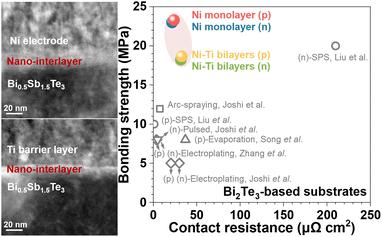原位形成的纳米间层可以在高效的bi2te3基热电模块中实现坚固的界面键合
IF 9.5
2区 材料科学
Q1 CHEMISTRY, PHYSICAL
引用次数: 0
摘要
热电电极连接处的界面稳健性,以优异的高温化学稳定性和机械完整性为特征,成为设备使用寿命的关键决定因素。尽管势垒层在减轻界面化学反应/扩散方面的功效已得到证实,但大规模制造强键合热电势垒电极界面仍然是一个艰巨的挑战。在这项研究中,我们展示了通过工业可扩展磁控溅射工艺在bi2te3基热电材料上可控和可重复地制造Ni电极和Ti势垒层。令人印象深刻的是,原位形成的纳米间层在所有异质结上都形成了原子键,实现了优异的键合强度(~ 23 MPa)和极低的接触电阻率(~ 21 μΩ cm2)。这些最终使一对热电模块在热侧温度为~ 298 K时达到~ 53 K的冷却效果,并在温度梯度为~ 180 K时保持~ 4.8%的转换效率。这项工作展示了在热电器件中构建跨多个功能层的健壮接口的通用制造路线。本文章由计算机程序翻译,如有差异,请以英文原文为准。

In situ formed nano-interlayer enables robust interface bonding in efficient Bi2Te3-based thermoelectric modules
Interfacial robustness at thermoelectric–electrode junctions, characterized by exceptional elevated-temperature chemical stability and mechanical integrity, emerges as a critical determinant for the operational longevity of devices. Despite the proven efficacy of barrier layers in mitigating interfacial chemical reaction/diffusion, large-scale fabrication of strongly bonded thermoelectric–barrier–electrode interfaces remains a formidable challenge. In this study, we demonstrate a controllable and reproducible fabrication of Ni electrodes and Ti barrier layers on Bi2Te3-based thermoelectric materials via an industrially scalable magnetron sputtering process. Impressively, an in situ formed nano-interlayer creates atomic bonding at all heterojunctions, achieving an outstanding bonding strength of ∼23 MPa with a competitively low contact resistivity of ∼21 μΩ cm2 at the junctions. These eventually enable one-pair thermoelectric modules to achieve a ∼53 K cooling effect at the hot-side temperature of ∼298 K and a sustained ∼4.8% conversion efficiency at a temperature gradient of ∼180 K. This work demonstrates a universal fabrication route for constructing robust interfaces across multiple functional layers in thermoelectric devices.
求助全文
通过发布文献求助,成功后即可免费获取论文全文。
去求助
来源期刊

Journal of Materials Chemistry A
CHEMISTRY, PHYSICAL-ENERGY & FUELS
CiteScore
19.50
自引率
5.00%
发文量
1892
审稿时长
1.5 months
期刊介绍:
The Journal of Materials Chemistry A, B & C covers a wide range of high-quality studies in the field of materials chemistry, with each section focusing on specific applications of the materials studied. Journal of Materials Chemistry A emphasizes applications in energy and sustainability, including topics such as artificial photosynthesis, batteries, and fuel cells. Journal of Materials Chemistry B focuses on applications in biology and medicine, while Journal of Materials Chemistry C covers applications in optical, magnetic, and electronic devices. Example topic areas within the scope of Journal of Materials Chemistry A include catalysis, green/sustainable materials, sensors, and water treatment, among others.
 求助内容:
求助内容: 应助结果提醒方式:
应助结果提醒方式:


